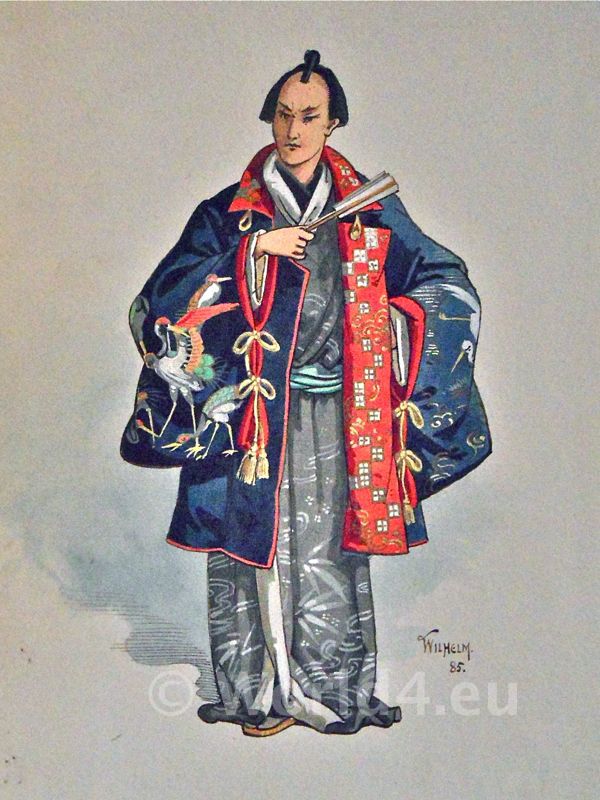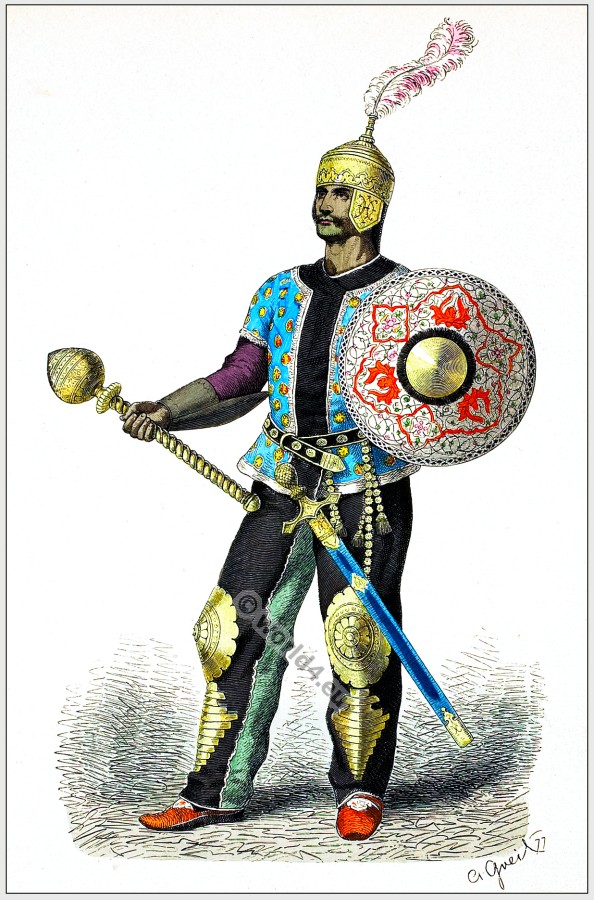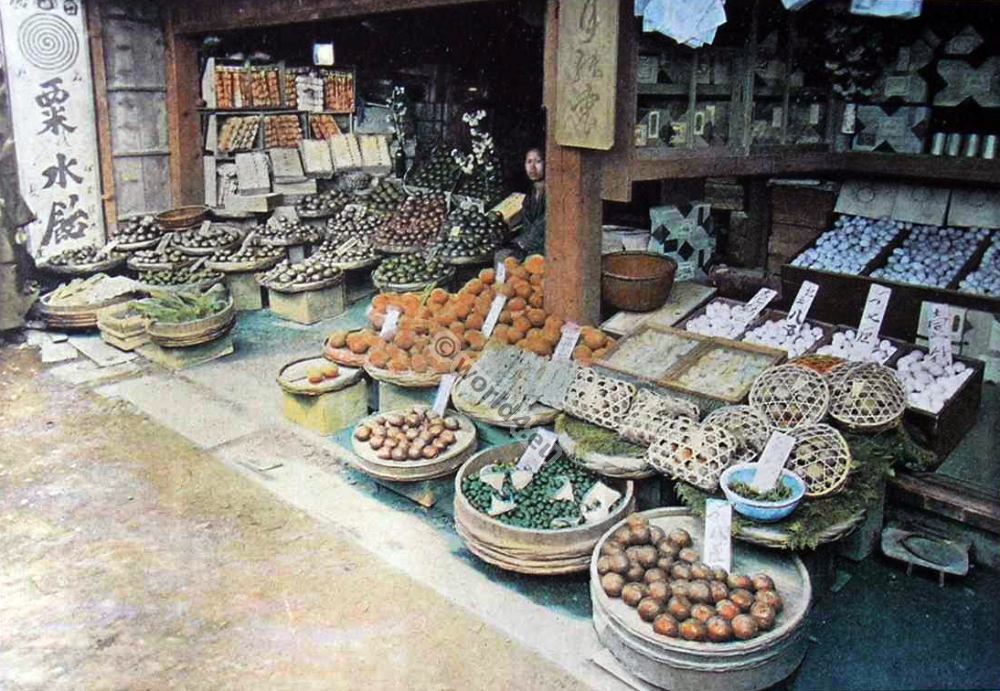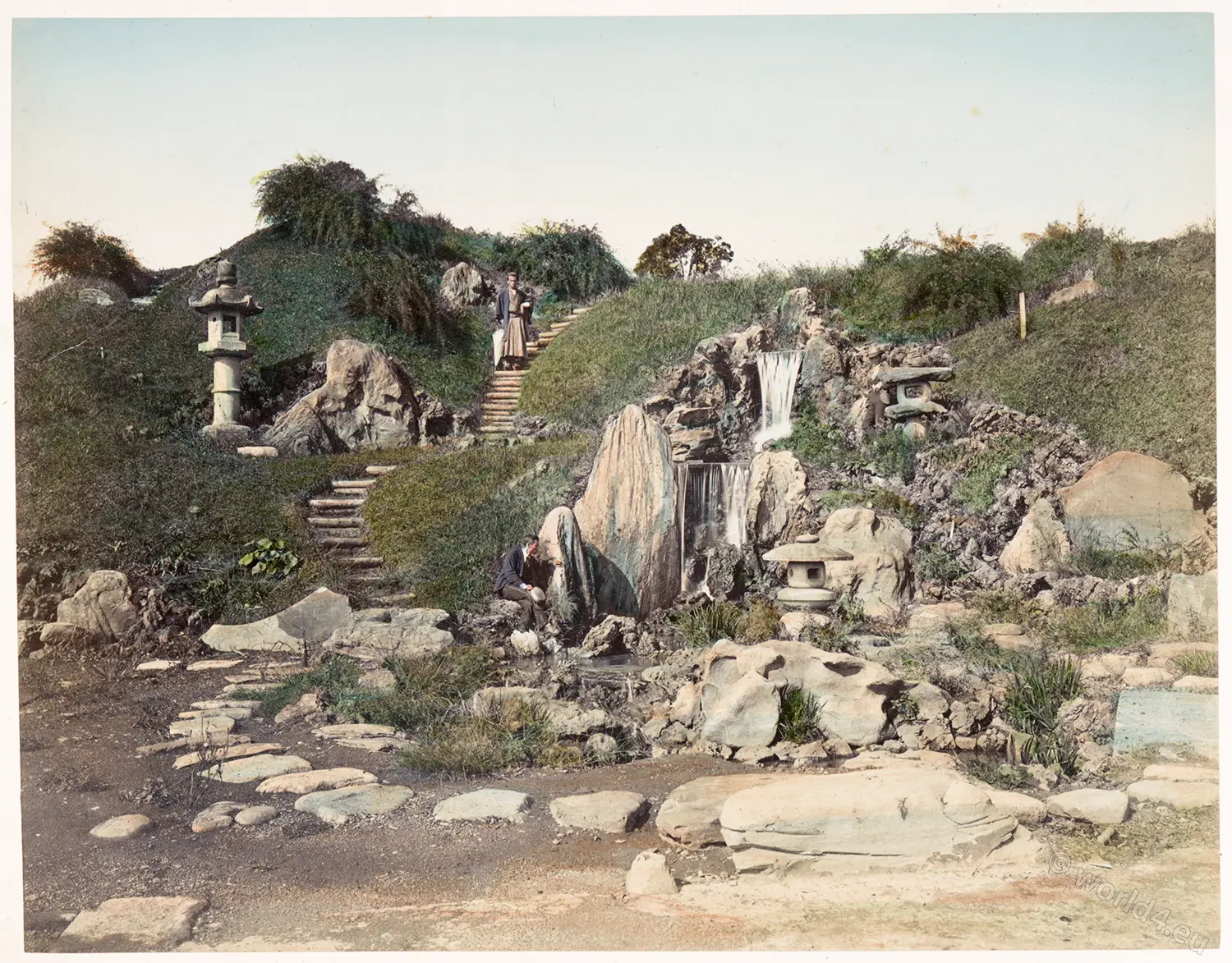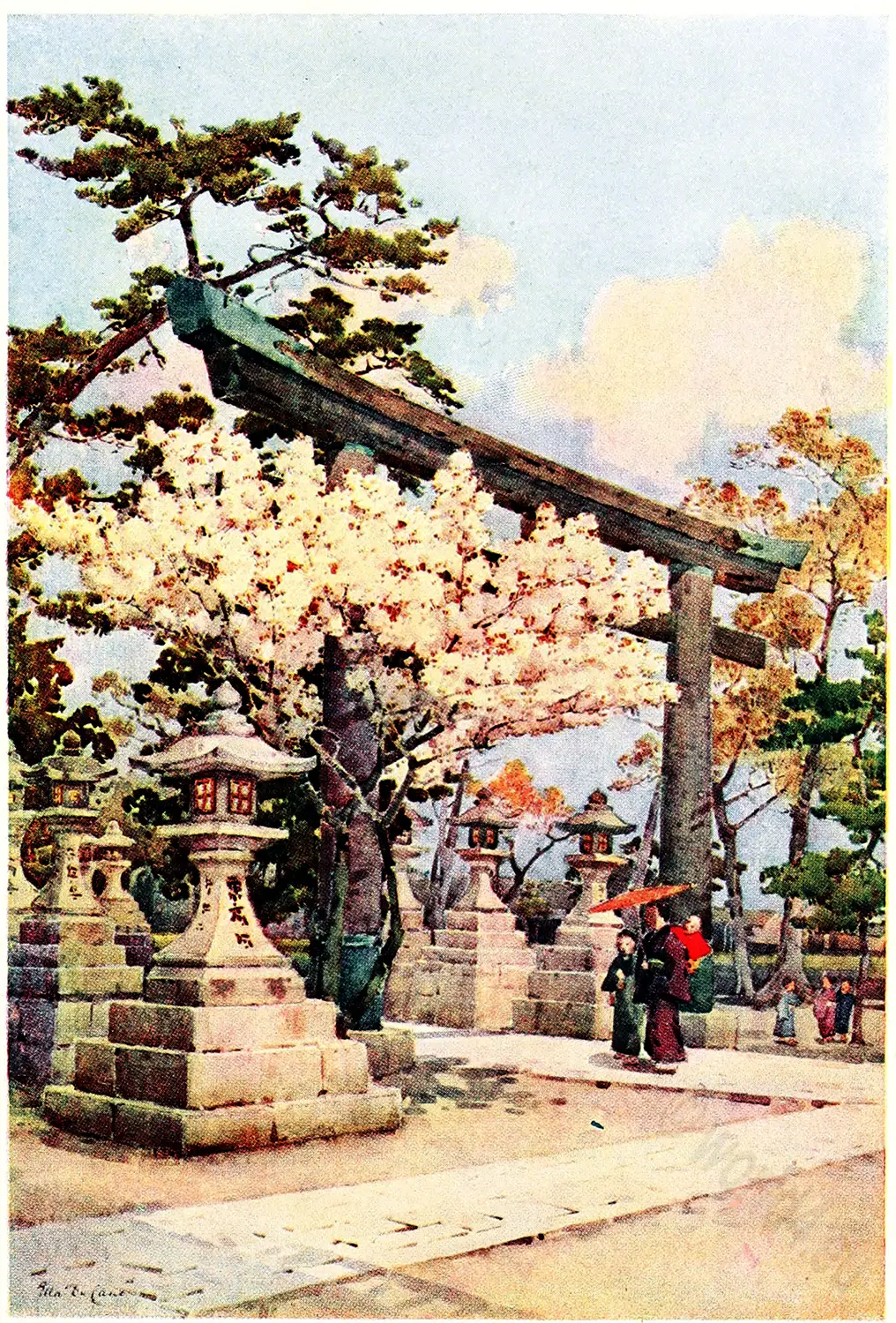This plate, taken from a Japanese coloured woodcut, illustrates well the voluminous nature of the medieval ceremonial garments. The figure is that of an ancient warrior of the Taira clan, to which Kagekiyo belonged, who was noted also for the high quality of his poetry.
He composed a special verse, which he fastened in an arrow that he always carried in his quiver, and that proved to be the means of identification when he was found by his enemies, dead in the field of battle.
AN ACTOR OF THE NOH IN FULL COSTUME
In the illustration one may particularly note the mask, with the eyebrows painted so high on the forehead that they are above the fillet band. The feet are not bare, but are covered with the white tabi, or cotton boots with soft soles and a separate division for the big toe, in which the Noh dancers always perform their parts.
Outline of the Story
The time of the action of the play is about the year 1190, and Kagekiyo, the hero of the story, is a very renowned warrior of the Taira clan. The Taira and the Minamoto (Gen) clans were rivals and were perpetually at war; during the years 1156-1185 more particularly this struggle culminated, when Japan had her ” Wars of the Roses.”
Kagekiyo, known as the Boisterous, owing to his uneven temper and ready appeals to arms, was a famous warrior of the Taira clan, and when the Minamoto Shogunate was established at Kamakura, Kagekiyo was exiled to a distant place in Hiuga, where he became blind and passed a miserable existence as a beggar.
He had a daughter called Hitomaru, whom he left in Kamakura in the charge of a lady. At the time of the play, Hitomaru has just grown up to be a young lady, but she had a great desire to meet her father, and so set out with a servant to seek him. She has a long and arduous journey to the place of her father’s exile, and after enduring considerable hardships she at last finds Kagekiyo’s retreat.
She and her servant encounter a villager who assists them in the final search for Kagekiyo, and they make inquiries of a blind beggar dwelling in a miserable straw hut.
This beggar is actually Kagekiyo, but at first he refuses to answer them or to acknowledge it, out of shame and consideration for his daughter. Ultimately, however, he recounts to her some of his adventures, and then he commands her to leave him and they part for ever.
Comments on the Play
In this play there is perhaps less description of the beauties of Nature than in many of the JVo, but the opening lines are particularly fraught with the meaning which permeates the whole play.
The dew remains until the wind doth blow.
Kagekiyo’s behaviour to his child, and his reception of her after her long search for him, appears to us to be most cruel; but it is, nevertheless, based on the conceptions of the chivalry of his time.
Kagekiyo’s leading thought was the really unselfish desire to keep the shame of his condition from touching his daughter.
His first wish is that she shall not even recognise or speak with him; but when this is frustrated, he commands both the servant and the villager to send her back immediately their short meeting is over.
And yet he does not seek even a moment’s embrace, nor does he use an endearing phrase to his daughter.
The play is a good illustration of the way that the old codes of Japanese chivalry imposed courses of action which seem now in this softer age well-nigh inhuman in their repression and conquest of the natural feelings.
DRAMATIS PERSONAE
Kagekiyo – Shite
Hitomaru, Kagekiyo’s daughter – Tsure
Servant to Hitomaru
Villager – Waki
Chorus
SCENE:
A mountain side at Miyasaki in the province of Hiuga. Time about 1190.
Source: Plays of Old Japan, the ‘Nō’: The ‘Nō’, by Marie Carmichael Stopes, Jōji Sakurai. Publisher W. Heinemann, 1913.

Fujiwara no Kagekiyo (unknown date of birth – 1196?) Fujiwara no Kagekiyo was a samurai from the late Heian to the early Kamakura period. He was the son of Fujiwara no Tadakiyo.
He fought in the service of the Heike clan and followed them into the capital, and is commonly known as Taira Kagekiyo under the surname Taira, but he was a descendant of Fujiwara Hidesato of the Ise Fujiwara clan (Ito clan), also known as Ito Kagekiyo. Commonly known as Ueso Shichiro (because he was the seventh son of Uesosuke Tadakiyo). Shinano no Mamoru (d. 1180), Lieutenant Hyoue. He was so valiant that he was nicknamed ‘Akushichibyoe’ (悪七兵衛).
He was active in the Jisho and Juei wars (Genpei wars) in the late Heian period. He is particularly famous for his ‘shikoro-iki’, in which he ripped off the shikoro (bucktooth shields) of Mioya Juro on the Genji side with his bare hands in the ‘Tale of the Heike’, scroll 11, ‘Yumi-ryu’. He was captured after his defeat at the Battle of Dannoura, and according to one theory, he was left in the custody of the Hatta Chie family, where he fasted and died.
The ‘evil’ in ‘Aku Nanbei’ does not mean a villain, but rather refers to bravery in the same way as ‘rogue’, although some traditions suggest that the name came about because he became suspicious and killed his uncle Dainichibusa Nohinobu, who had sheltered him after his defeat at Dannoura. In recent years, however, the prevailing theory is that he died of illness or accident.
Although he actually existed, his life is a mystery and he is rarely treated as a so-called ‘Heike no Orabito’, but there are various legends about him in different parts of the country. For this reason, he is often featured as a protagonist in various creative works.
In later times, people who felt sorry for Fujiwara no Kagekiyo built a tomb for his memorial service, which is located at Koyoji Temple, Higashiyodogawa-ku, Osaka.
According to the description in Azuma Kagami, Kagekiyo had an elder brother named Kamihara Gorohei Lieutenant Tadamitsu, who, during the construction of Eifukuji Temple in Nikaido, Kamakura, tried to assassinate Minamoto no Yoritomo by hiding out among the earthworks, but was caught under suspicion.
Image: Eight Views of Yomu: The Kusatsu Bell at Todaiji Temple. (歌川国芳 Utagawa Kuniyoshi, 1798 – 1861)
Discover more from World4 Costume Culture History
Subscribe to get the latest posts sent to your email.




